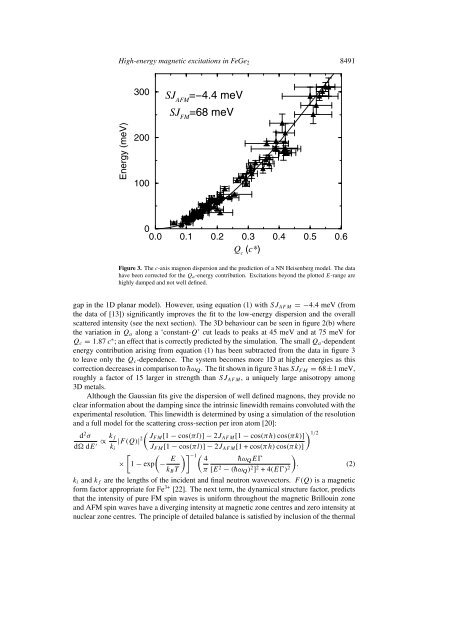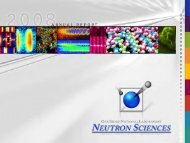ARCS materials - Spallation Neutron Source - Oak Ridge National ...
ARCS materials - Spallation Neutron Source - Oak Ridge National ...
ARCS materials - Spallation Neutron Source - Oak Ridge National ...
You also want an ePaper? Increase the reach of your titles
YUMPU automatically turns print PDFs into web optimized ePapers that Google loves.
High-energy magnetic excitations in FeGe2<br />
Energy (meV)<br />
300<br />
200<br />
100<br />
SJ =−4.4 meV<br />
AFM<br />
SJFM =68 meV<br />
0<br />
0.0 0.1 0.2 0.3<br />
Qc (c*)<br />
0.4 0.5 0.6<br />
8491<br />
Figure 3. The c-axis magnon dispersion and the prediction of a NN Heisenberg model. The data<br />
have been corrected for the Qa-energy contribution. Excitations beyond the plotted E-range are<br />
highly damped and not well defined.<br />
gap in the 1D planar model). However, using equation (1) with SJAF M =−4.4 meV (from<br />
the data of [13]) significantly improves the fit to the low-energy dispersion and the overall<br />
scattered intensity (see the next section). The 3D behaviour can be seen in figure 2(b) where<br />
the variation in Qa along a ‘constant-Q’ cut leads to peaks at 45 meV and at 75 meV for<br />
Qc = 1.87 c∗ ; an effect that is correctly predicted by the simulation. The small Qa-dependent<br />
energy contribution arising from equation (1) has been subtracted from the data in figure 3<br />
to leave only the Qc-dependence. The system becomes more 1D at higher energies as this<br />
correction decreases in comparison to ¯hωQ. The fit shown in figure 3 has SJFM = 68±1 meV,<br />
roughly a factor of 15 larger in strength than SJAF M, a uniquely large anisotropy among<br />
3D metals.<br />
Although the Gaussian fits give the dispersion of well defined magnons, they provide no<br />
clear information about the damping since the intrinsic linewidth remains convoluted with the<br />
experimental resolution. This linewidth is determined by using a simulation of the resolution<br />
and a full model for the scattering cross-section per iron atom [20]:<br />
d2σ kf<br />
∝ |F (Q)|<br />
d dE ′<br />
ki<br />
2<br />
1/2 JFM[1 − cos(πl)] − 2JAF M[1 − cos(πh) cos(πk)]<br />
JFM[1 − cos(πl)] − 2JAF M[1 + cos(πh) cos(πk)]<br />
<br />
× 1 − exp − E<br />
−1 4 ¯hωQEƔ<br />
kBT π [E2 − (¯hωQ) 2 ] 2 +4(EƔ) 2<br />
<br />
. (2)<br />
ki and kf are the lengths of the incident and final neutron wavevectors. F (Q) is a magnetic<br />
form factor appropriate for Fe3+ [22]. The next term, the dynamical structure factor, predicts<br />
that the intensity of pure FM spin waves is uniform throughout the magnetic Brillouin zone<br />
and AFM spin waves have a diverging intensity at magnetic zone centres and zero intensity at<br />
nuclear zone centres. The principle of detailed balance is satisfied by inclusion of the thermal

















